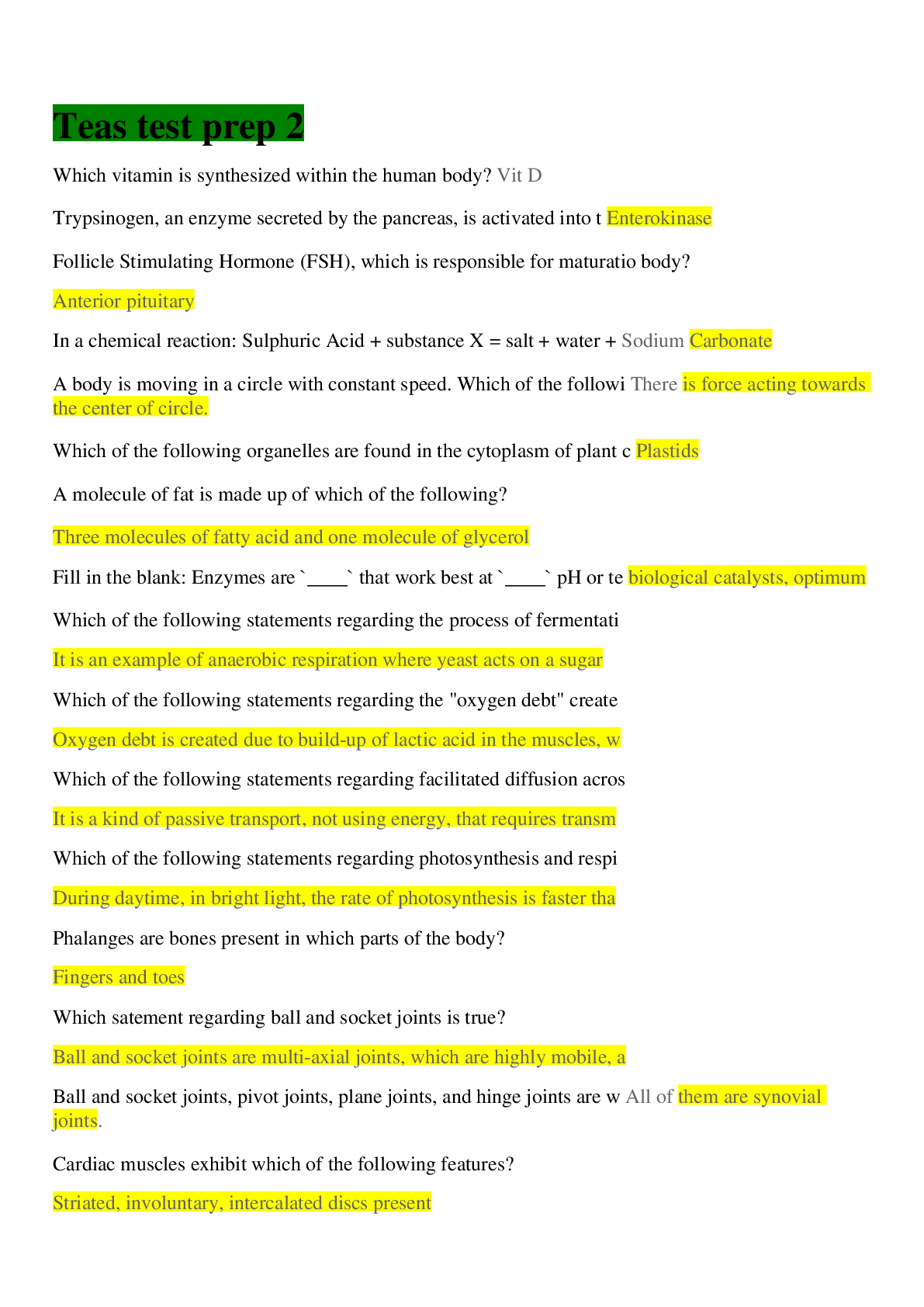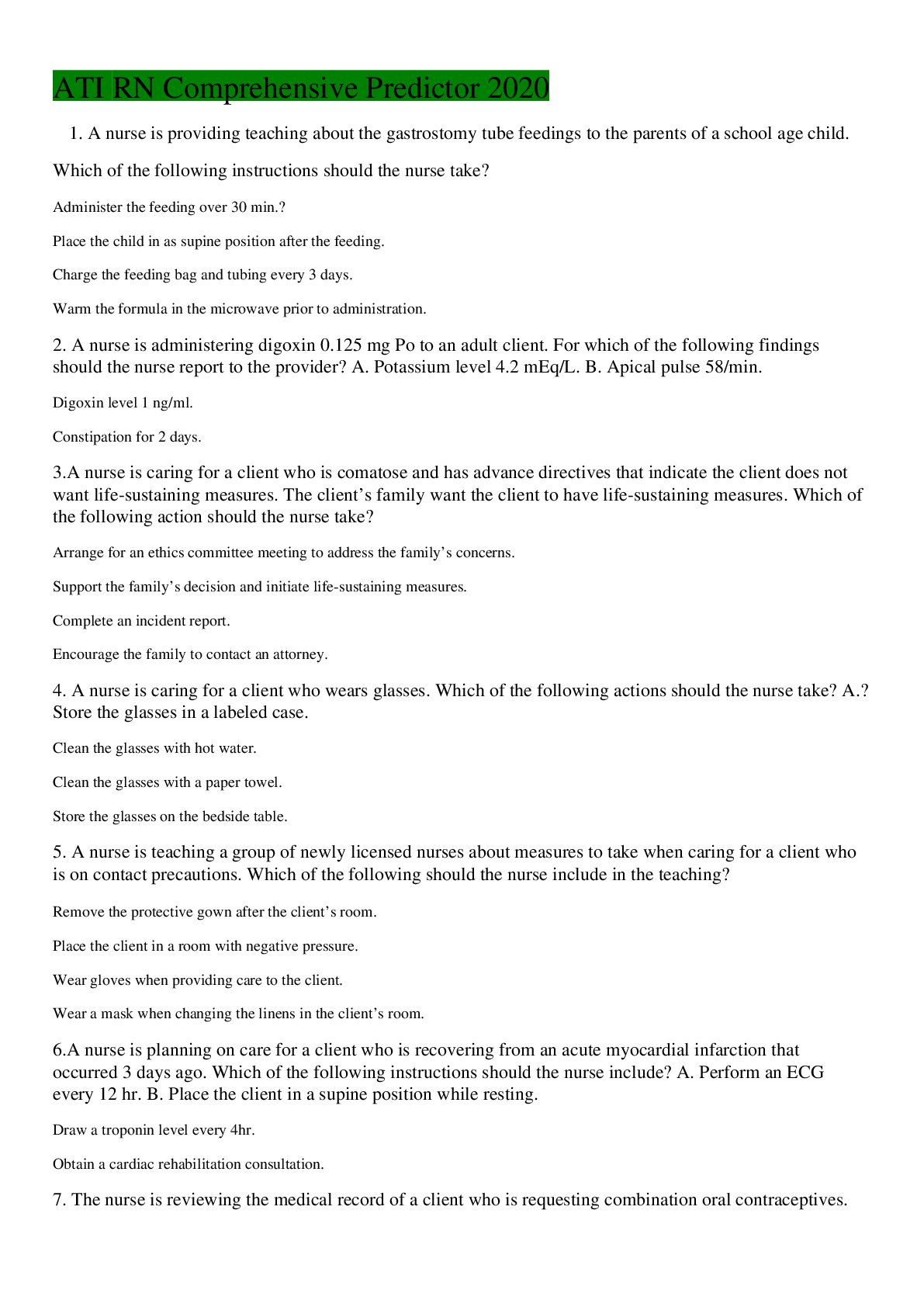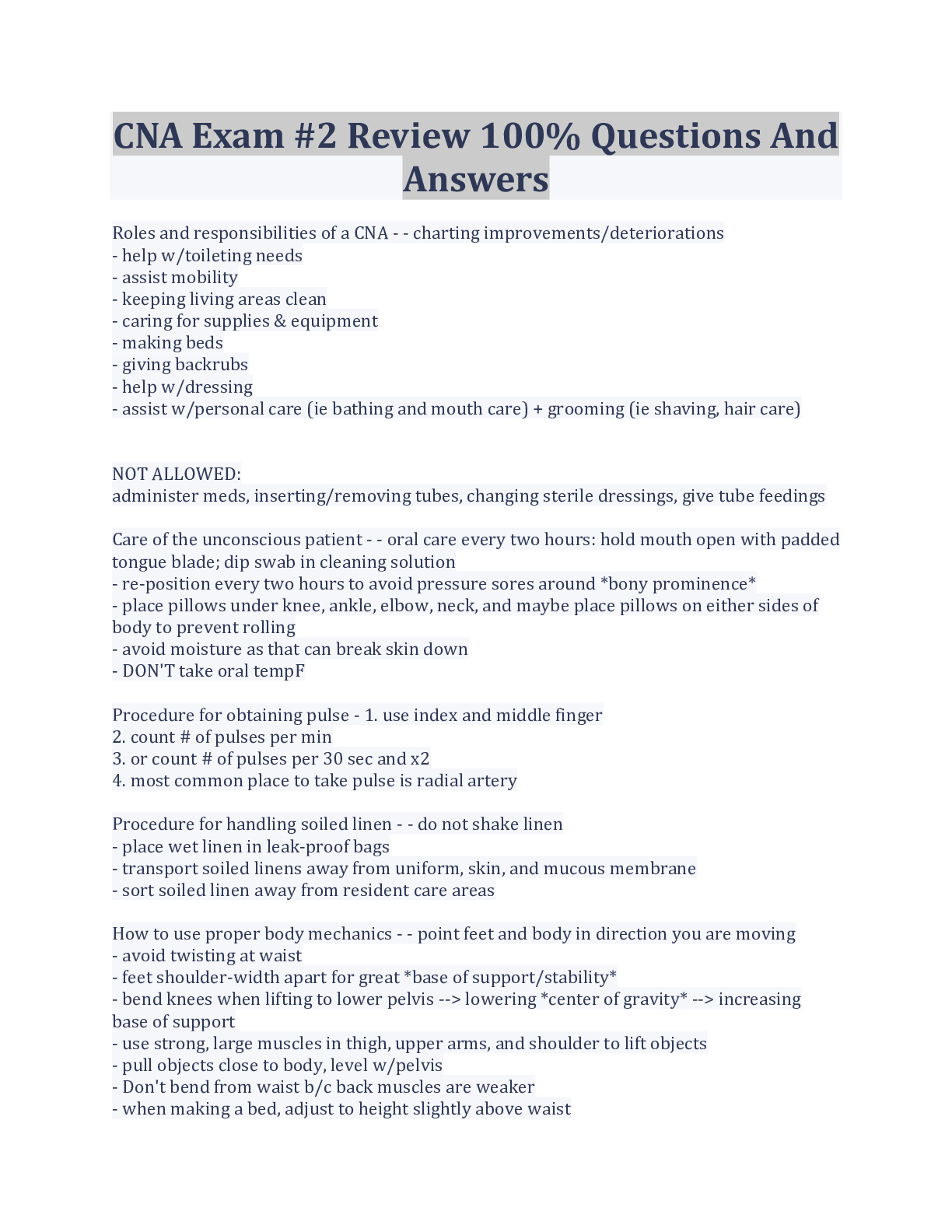Anatomy > EXAM > Anatomy & Physiology > Physiology –biology 161 -Lecture Exam #2 Review test bank(latest (All)
Anatomy & Physiology > Physiology –biology 161 -Lecture Exam #2 Review test bank(latest
Document Content and Description Below
Anatomy & Physiology > Physiology –biology 161 -Lecture Exam #2 Review test bank(latest) Physiology –biology 161 -Lecture Exam #2 Review PPT 1 – SYNAPSES TO SUMMATION 1. Explain what is meant b... y a graded potential. Differentiate between a graded potential and an action potential. 2. Describe the anatomy and physiology of a synapse. What is the function of it, and what type of chemical must cross the synapse to stimulate the next cell? 3. Explain the differences between excitatory and inhibitory synapses, as well as the importance of having both types to balance each other. 4. Define synaptic delay, and explain why additional synapses cause an increase in impulse travel time. 5. Trace the pathway of a reflex arc, and understand the functions of each of its five components. 6. Compare and contrast temporal summation versus spatial summation in nervous pathways. PPT 2 – ENDOCRINE SYSTEM PART 1 7. Define the term hormone. Explain where hormones are released in the body, and why each hormone only affects specific cells. Which type of feedback system is used to regulate the majority of the body’s hormones? 8. Compare and contrast the nervous system with the endocrine system. PPT 3 – ORGANIZATION OF THE NERVOUS SYSTEM 9. Describe the functions of the nervous system, as well as the various subdivisions within the nervous system. 10. Contrast afferent versus efferent. 11. Explain brain plasticity and its relation to learning. 12. Explain the importance of maintaining homeostatic conditions within the area of the brain. What is the blood-brain barrier, and how does it contribute to homeostasis for the brain? 13. Discuss why the blood flow and blood pressure to the brain are relatively steady. 14. Review the various regions of the brain, and explain their functions. 15. Be able to discuss the names and various subdivisions of the peripheral nervous system, and note whether they are under conscious or subconscious control. 16. We are consciously aware of some sensations; be able to discuss them. Differentiate between sensation and perception. 17. List and discuss various types of specialized sensory receptors. 18. Explain the various aspects of pain sensation that were discussed in class. Differentiate between A and C fibers. Discuss the various effects of bradykinins. 19. Differentiate among superficial somatic, deep somatic, and visceral categories of pain. 20. Explain what referred pain is, and understand why it is a common cause of clinical misdiagnoses. 21. Define the term transduction. 22. Describe sensory receptor adaptation, and differentiate between tonic and phasic receptors. Why is it that some sensory receptors do not adapt? 23. Define sensory acuity, and explain characteristics that can increase sety. PPT 4 – PNS EFERENT 24. How do the sympathetic and parasympathetic divisions differ from each other? What are their effects on various effector organs? 25. Note examples of effector organs that are only controlled by sympathetic activity. 26. Describe efferent autonomic nerve pathways. Distinguish between preganglionic and postganglionic neurons, and note the different neurotransmitters used at the various synapses by the sympathetic and parasympathetic divisions. and NE in sympathetic. 27. How does the medulla of the adrenal gland relate to the sympathetic response of the nervous system? 28. Explain the types and roles of the various autonomic receptors, and explain why a particular neurotransmitter may have different effects on different effector organs. 29. Compare and contrast a neuromuscular junction with a synapse in the nervous system. Which neurotransmitter is used at the neuromuscular junction? PPT 5 – MUSCLE PHYSIOLOGY 30. Describe the various events at the neuromuscular junction. 31. Review the anatomy and associated terminology for skeletal muscle. Know the various levels of skeletal muscle organization. 32. Differentiate between myosin and actin. 33. Discuss the importance of the sliding filament model of muscle contraction. 34. Explain the steps of skeletal muscle contraction, beginning with stimulation of the muscle fiber by the motor neuron. Note the roles of troponin and tropomyosin. 35. Describe the use of ATP within skeletal muscle cells. 36. Once exercise begins, explain the various sources of ATP for the skeletal muscle, in order of their use. Note where glycogen is stored within the body. 37. Describe the fate of lactate (or lactic acid) when it is produced in muscle cells during anaerobic glycolysis. What causes muscle soreness after a long, hard workout? 38. Compare and contrast isometric contractions with isotonic contractions. 39. Compare and contrast details regarding aerobic exercise versus resistance (anaerobic) exercise. 40. Differentiate between spatial summation and temporal summation in skeletal muscle 41. Describe the physiology of muscle fatigue, and why skeletal muscles must rest before resuming hard work. 42. Discuss the amount of heat production that occurs during skeletal muscle activity, and explain the body functions that prevent a person from overheating during exercise. 43. Note some unique differences among skeletal muscle, cardiac muscle and smooth muscle with respect to their anatomical and contractile characteristics. 44. Review the heart anatomy. 45. Explain why the heart is described as a double pump. Contrast the function of the right side of the heart versus the left side of the heart. 46. Describe the detailed blood pathway through the body (i.e., be able to follow a drop of blood along its pathway). 47. Arteries typically transport blood relatively high in oxygen, and veins typically transport blood relatively low in oxygen. Where does the exception to these rules occur in the body? 48. Describe the electrical characteristics of cardiac muscle cells, and explain the importance of intercalated disks. 49. Know the typical electrical pathway through the heart, beginning with the sinoatrial node. 50. Explain the details of the electrical conduction in the heart, beginning with the sinoatrial node and ending with the Purkinje fibers. Relate this electrical conduction to contraction of the heart’s atria and ventricles. 51. Know the average rates of action potentials for the various types of autorhythmic cells within the adult heart. 52. Know the average adult resting heart rate, as well as the terminology and average beats per minute for a fast or slow adult heart rate. 53. Note the location of the calcium ion source for cardiac muscle contraction. 54. Explain how the heart prevents the atrial contraction (atrial systole) from occurring at the same time as ventricular contraction (ventricular systole). Why is this important to heart function? 55. What type of cell junction is used to spread electrical impulses between cardiac muscle cells? 56. Describe fibrillation of cardiac muscle, and explain why atrial fibrillation is typically not considered an immediate danger, while ventricular fibrillation can be life-threatening within minutes. 57. Define defibrillation of cardiac muscle and its importance to medicine. 58. Explain why action potentials within the heart are typically slower than action potentials in neurons or skeletal muscle cells. 59. How is the heart protected from experiencing tetany? LAB LECTURE -6.19- IMMUNOLOGY 60. The immune system works throughout the entire body. What are the three levels of defense that the immune system provides for us? 61. Describe the various surface barriers that intact skin and mucous membranes provide for us. 62. Compare and contrast the various aspects of innate vs. adaptive immunity in the body. 63. Discuss the steps that the immune system may take to protect the body and destroy invasive microorganisms when the body is injured and invaded by pathogens. [Show More]
Last updated: 2 years ago
Preview 1 out of 13 pages

Buy this document to get the full access instantly
Instant Download Access after purchase
Buy NowInstant download
We Accept:

Reviews( 0 )
$13.00
Can't find what you want? Try our AI powered Search
Document information
Connected school, study & course
About the document
Uploaded On
Jun 19, 2020
Number of pages
13
Written in
Additional information
This document has been written for:
Uploaded
Jun 19, 2020
Downloads
0
Views
145









.png)









